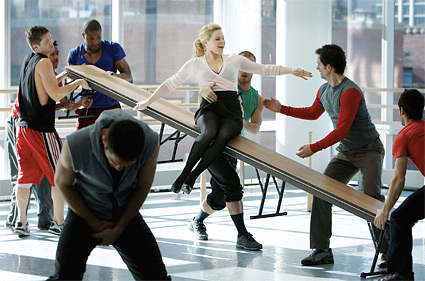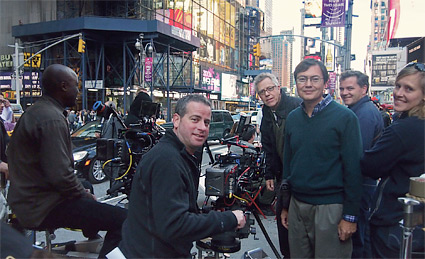Lighting 'Smash'
HOLLYWOOD: Cinematographer David Mullen, ASC ("Big Love," "United States of Tara"), takes on some unusual lighting challenges for his work on the new musical theater-themed NBC series, "Smash." The show from Universal Television and DreamWorks takes a look at the exciting world of Broadway theater as it follows a disparate group of characters as they attempt to mount the major Marilyn Monroe-themed musical production they hope will take the Great White Way by storm. The show follows the creators, producers, stars, and those hoping for stardom (the cast includes Debra Messing, Katharine McPhee, Anjelica Huston, and many others) as it takes an entertaining and dramatic look at the magic of the theater from a wide array of perspectives.
Settings for the show run the gamut from all-out stage musical numbers to naturalistic storytelling as we follow the various characters through the tribulations of their personal and professional lives.

"Smash" debuted on NBC in January. Lighting for the full-fledged musical sequences is overseen by major Broadway theatrical lighting director Donald Holder ("Spiderman") and he has the time and tools to mount actual numbers as he would for a live show. He can spend two days programming lighting cues to the SMPTE timecode of the music playback and then work with Mullen on the day of the shoot refining what might be a perfect lightshow for a live audience to work in the very different kind of situation where two or even three Steadicam or crane-mounted cameras need to get in close to the performers.
"We go through shot by shot," said Mullen of his collaboration with Holder, "and then when we spot a shadow that doesn't belong there, he can go in and alter his program to maybe use a different light from somewhere else to accomplish the same effect."
'IN BETWEEN REALITY'
But in-between these full-fledged theatrical numbers and the regular dramatic scenes that occur in places such as rehearsal halls, offices and apartments, there is also a kind of "in-between reality" to much of "Smash"—a world in which the viewer is watching something "real" but enhanced by the characters' vivid imaginations.
These often quite elaborate musical sequences are entirely the domain of Mullen and his lighting crew, led by gaffer Bill Almeida.
"These scenes can take place anywhere," Mullen explained. "We can be in the middle of a [traditionally-shot] scene and suddenly the room becomes a more fantastical place and they start to break into song in their mind. Other times you're not supposed to be sure where they are. They're in kind of a limbo singing, dancing. These kinds of scenes can run the gamut between very simple and very complicated. I'm learning by trial and error what the best ways are of creating these moments that aren't full-on Broadway stage numbers or normal dramatic scenes but something in-between."
While the Broadway lighting makes extensive use of HMI and LED units, Mullen prefers to use tungsten light wherever possible. "I like the 'dimmability' of tungsten lights," he noted. "I constantly need to adjust the light output by very small amounts and it's so easy to either run them through a dimmer board or put them on Variacs before we roll. I also think that for cinematography, tungsten is a nicer color light on the face. HMIs and LEDs can have a small green bias or other tints where I feel I'm not getting a true 'white light' out of them."
HYBRID SCENES
The show, shot on a series of stages in New York, (in the Long Island City portion of the borough Queens and Brooklyn's Green Point), makes use of one relatively small stage in a converted warehouse with ceilings too low to do a full-on Donald Holder setup. But the flexibility allows for some performances that can either appear to be on a stage (though the "audience" must be obscured by blackness or lens flair) or it can operate more as a kind of "limbo world" inside a character's imagination.

David Mullen, ASC , and the "Smash" crew on location in Times Square. Mullen has tried quite a few approaches to give each of these fantasy or semi-fantasy numbers a kind of unique feel. "Sometimes I'll get some intense backlighting from 'firestarter' PAR cans and then I'll just fill the actor's face with a white card right by the camera," he said. "Of course that's not something you would do in a real stage show but it's a nice effect for this kind of scene. I might use an ETC Source 4 as a follow spot or, instead, I might have a 2K Chimera on a dimmer that could subtly fade up and give me a very soft key light."
Since these scenes are either entirely or partially fantasy, Mullen explains, the traditional concerns about "motivation" of the light really isn't all that important.
The first of these hybrid-type scenes that Mullen shot involved McPhee's character, Karen, inside a dance rehearsal space lit by daylight through windows. In her mind, she transforms into a fully-realized routine with Katherine in character as Marilyn Monroe performing a number called "The 20th Century Fox Mambo."
"The space has a low warehouse ceiling with just some overhead fluorescent lighting," the cinematographer said. "These lights aren't dimmable. They're either on or off. So I knew I couldn't have one lighting cue where the room could transform from fluorescent to a stage show look. In that case, we conceived of hiding the transition in a cut, rather than a dimmer board cue. So there is a hard cut to the fantasy and I gelled all the windows on the set with a deep, pink gel and I put rows of old-fashioned looking movie lights—open-eyed 5Ks—in a row right outside the windows in front of the New York City backdrop. We took the lighting off the backing and left the 5Ks and a smaller row of PAR cans all pointed into the camera lens through this pink gel, and used a gold gel over [an ETC] Source Four. We used that as a follow spot on her.
"So that was how we transformed this bright fluorescent-lit space into a darker area with pin and gold lighting," Mullen added. "Then we had the 5Ks and the PAR cans on a dimmer board and our dimmer board operator, working on the fly, could flash them up at full intensity during peak moments in the song and then dim them back to a lower level so they were kind of pulsing to the music."
It's fun and challenging," Mullen remarked of the work. "You have to think in bold strokes and come up with exciting lighting cues all the time. We've done them enough to know the basic ways to shoot in terms of lighting, but each dance number is unique unto itself so the lighting has to be conceived from the ground up."
Get the TV Tech Newsletter
The professional video industry's #1 source for news, trends and product and tech information. Sign up below.
